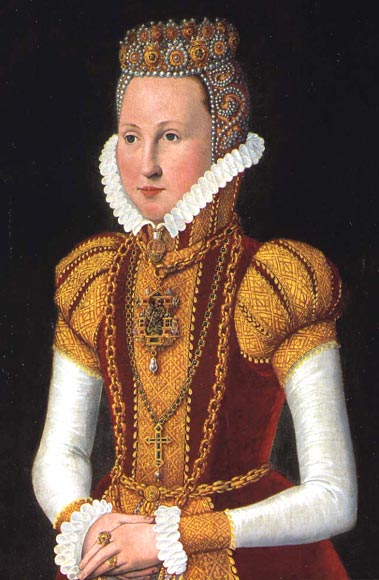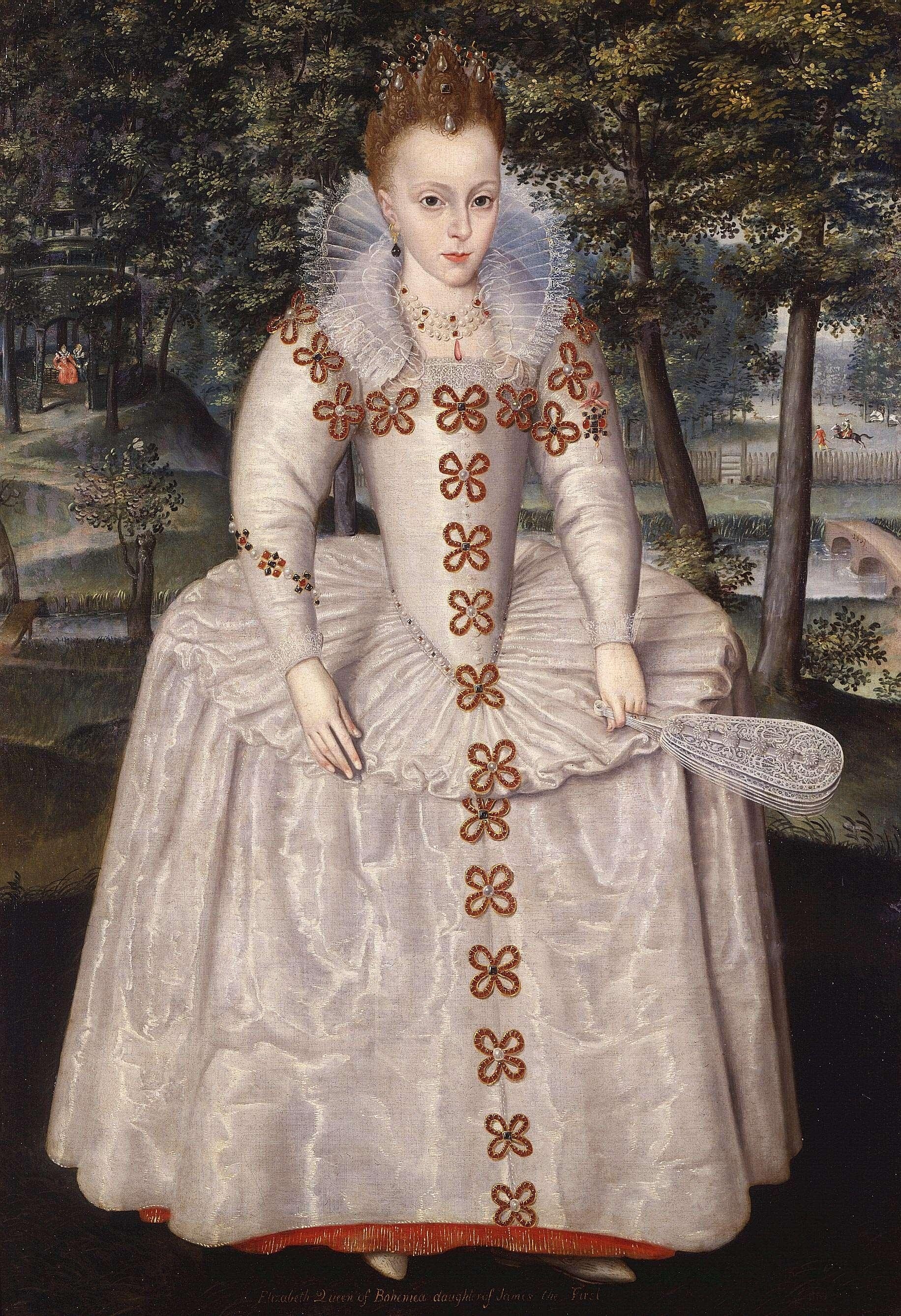Marriage
 |
| Frederick II of Denmark |
Although
James did not enjoy the company of women, perhaps the dour Lady Mar had put him
off, he knew that it behoved him to marry and produce children. He said of his
bachelorhood;
‘This my nakedness made me
to be weak and my enemies strong, and the want of succession bred disdain.’[i]
The English
party in Scotland were desperate to avoid a marriage with France and been
pushing for James to marry one of the two daughters of Frederick II of Denmark and his wife Sophie of Mecklenburg-Güstrow; the girls had the advantage of
being Protestant. Another prospect was Arbella Stuart[ii], daughter of the Earl of Lennox and
a possible rival claimant to the throne of England.
In the event
James chose Anne, the 14 year old princess of Denmark
who came with a very useful dowry of £150,000[iii]. When Anne became
marooned in the winter snows in Norway en route to her new home, James
travelled to Oslo to meet her, he wrote a poem for her;
‘The seas are now the bar
Which make us distance far
That we may soon win near
God grant us grace.’[iv]
 |
| Queen Consort of Denmark |
Anne and
James had to converse in French, while James spoke to the Norwegians in Latin.
The wedding was performed in Oslo and James travelled to Denmark with Anne
where they over wintered following a second wedding. The couple arrived in
Scotland on 1st May 1590.
Anne’s
coronation was a source of conflict; the Kirk wished to purge the ceremony of
all Catholic rituals, in particular the anointing. But James was adamant on
this point; for him the anointing reflected his view that kings were kings by
the grace of God, not the people. A witness recorded that;
‘The Countess of Mar went up
to the queen and bared a little of the queen’s right arm and shoulder. Robert
Bruce[v]
immediately poured the queen’s oil onto her bare arm and shoulder.’[vi]
Anne had
been promised that she could freely exercise her Lutheran religion, but the
Kirk was to pressurise her to accept their version of Protestantism. The Kirk
was much dismayed to discover that Anne loved dancing and she encouraged the
Scottish court to become more formal.  |
| Anne's coat of arms as Queen Consort of Scotland |
James was
happy to encourage Anne and he indulged her love of clothes and jewellery. In
return Anne joined him on his hunting expeditions. He called her ‘my Annie’.
Anne quickly learnt to write and speak Scots and by the age of 18 had become
politically active. Her friends were not James’ friends, but James was prepared
to listen to Anne’s opinions even if he did not agree with her.
By the Pricking of My Thumbs
The Danish
admiral, who escorted the Queen on her journey to Scotland, blamed the storms
that marooned them in Norway on the wife of a Copenhagen burgess, with whom he
had quarrelled. She confessed under torture that she was a witch and was burned
in September 1590. In Denmark James was introduced to new European beliefs on
witches and he used these in his treatise Daemonologie[vii] that he later published in support
of persecuting witches.
The Kirk had
long been interested in searching out witches and covens but until his return
from Denmark had been unable to interest James in the hunt. All that changed
when a coven was unearthed in Berwick which was allegedly planning to kill the
king.
‘That another might rule in
his Majesty’s place and the government might go to the Devil.’[viii]
Francis Bothwell[ix] was reputed to be involved in this
Demonic pact. The witches had cast cats and dead body parts into the sea to
raise storms while James was sailing to meet Anne. James attended the trials
and was amazed to discover that the witches knew of conversations between
himself and Anne in Norway; a wave of persecution followed. _c.1581.jpg/744px-Braun_&_Hogenberg_'Castrum_Puellarum'_(Edinburgh_Castle)_c.1581.jpg) |
| 16th century |
Bothwell was
incarcerated in Edinburgh castle but escaped and, on 27th
December 1591 with an unruly bunch of followers, bearded James at Holyrood; James was saved by Edinburgh’s citizens. Bothwell managed
to escape again and in 1592 the Scottish Parliament forfeited Bothwell’s lands
and possessions[x].
Children
Prince Henry was born in February 1594 and Anne
was shocked to discover that the child was to be brought up at Stirling Castle
by the Earl of Mar, who would become Regent in the
event of anything happening to James. He told Anne;
‘If some faction got strong
enough, she could not hinder his boy being used against him, as he himself had
been used against his unfortunate mother.’[xi]
 |
| Elizabeth age 7 |
In August 1596
Anne gave birth to Elizabeth who had as her sole Godmother the
Queen of England. Elizabeth was sent to live with Lord and Lady Livingstone along with her younger sister Margaret who died at the age of two in 1598. Prince
Charles was born in November 1600 and the
sickly child was placed under the care of Lord Fyvie, one of James’ friends.
Robert was born in January 1602 but died
four months later. There were two further children; Mary born in April 1605. Mary’s birth was
celebrated throughout England as she was the first child born to a reigning
English monarch for 68 years. Mary died in 1607, and finally there was Sophia born in June 1606 and lived one day. She was buried in Westminster Abbey in a cradle shaped tomb.
Over the years
the marriage gradually changed and the initial love between James and Anne
died. As Godfrey Goodman, Bishop of Gloucester said;
‘They did love as well as
man and wife could do, not conversing together.’[xii]
But Anne and
James did feel a companionship towards one another, despite their disparate
tastes.
The Throne in Peril
 |
| Earl of Essex |
In 1599
James was deeply concerned that his premier place as successor to Elizabeth was
in peril. His main supporter at the English court, the Earl of Essex, was in prison[xiii]. And the previous year
James had been accused of arranging an attempted assassination of Elizabeth by
an English Catholic.
In 1585 a
statute was enacted to bar those who plotted against the monarch from
inheriting the throne[xiv] and James feared that Robert Cecil[xv] had manufactured the confession. Elizabeth told James
that she believed in his innocence but would not state this assertion publicly.
James was ready to turn to arms and aid Essex’s supporters. James was
‘Not certain how soon he
should have to use arms but whenever it should be, he knew his right and would
venture crown and all for it.’[xvi]
To fund the
army James had to raise taxes and debase the coinage; unpopular moves. There
was also the chance that the Kirk, angry at James’ proposals to reintroduce bishops,
would take advantage of the growing public anger.
The Master of
Grey wrote to Cecil;
‘There was in men’s breasts
such a desire of reformation that nothing lacked save one gallant man for
uniting grieved minds.’[xvii]
The
ministers of the Kirk had already settled on the young Earl of Gowrie[xviii] who travelled to England, arriving
at court on 3rd April 1600. The young Gowrie met with Cecil and
Elizabeth before returning to Scotland in May, where he immediately joined the
opposition to raising taxes.
On 5th
August he and his brother Alexander were dead; James said that Alexander lured
him to Gowrie House claiming that his brother had captured a man carrying a
large amount of gold. James was separated from his men and Alexander attempted
to stab James who called for help. In the ensuing mêlée Alexander and Gowrie
were killed.
Robert Bruce
refused to accept the king’s account making it clear his belief that James had
plotted to kill the two brothers because he hated the family or because Anne
was having an affair with Alexander. James was most displeased;
‘I see, Mr Robert, that ye
would make me a murderer. It is known very well that I was never blood-thirsty.
If I had taken lives, I had causes enough; I need not to hazard myself so.’[xix]
Bruce was
sent into exile and the Ruthven sisters were thrown out, over Anne’s protests
when James returned home. James asked Elizabeth to exile the two remaining
Ruthven brothers, both schoolboys, and she did so.
Bibliography
The Early
Stuarts – Godfrey Davies, Oxford University Press 1987
King James –
Antonia Fraser, BCA 1974
Arbella –
Sarah Gristwood, Bantam 2004
Robert Cecil
– Alan Haynes, Peter Owen Publishers 1989
Walsingham –
Alan Haynes, Sutton Publishing 2004
After
Elizabeth – Leanda de Lisle, Harper Perennial 2006
Bess of
Hardwick – Mary S Lovell, Abacus 2006
[i]
King James - Fraser
[ii]
Granddaughter of Bess
of Hardwick her daughter Elizabeth
married Charles
Stuart, Earl of Lennox
[iii]
In 2011 the relative: historic standard of living value
of that income or wealth is £34,010,000.00
economic status value of that income or wealth is £1,248,000,000.00 economic power value of that income or wealth is £9,922,000,000.00 www.measuringworth.com
economic status value of that income or wealth is £1,248,000,000.00 economic power value of that income or wealth is £9,922,000,000.00 www.measuringworth.com
[iv]
King James - Fraser
[v]
A Privy Counsellor Bruce had helped keep the peace during James’ absence
[vi]
After Elizabeth – de Lisle
[vii]
Published in 1597
[viii]
King James - Fraser
[ix]
Earl of Bothwell, Lord High Admiral and Privy Counsellor. Francis was James’
cousin and Bothwell’s nephew
[x]
Bothwell eventually died in exile in Naples in 1612
[xi]
After Elizabeth – de Lisle
[xii]
King James - Fraser
[xiii]
For interrupting the queen as she was dressing
[xiv]
Aimed at Mary
[xvi]
After Elizabeth – de Lisle
[xvii]
Ibid
[xix]
After Elizabeth – de Lisle
No comments:
Post a Comment
Note: only a member of this blog may post a comment.